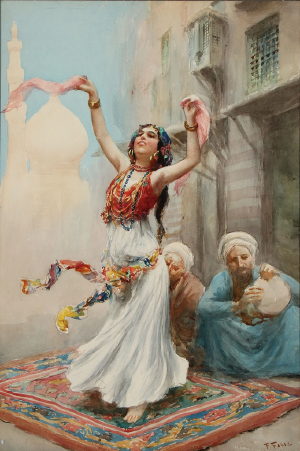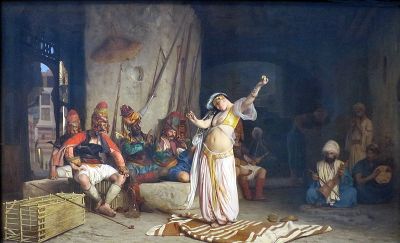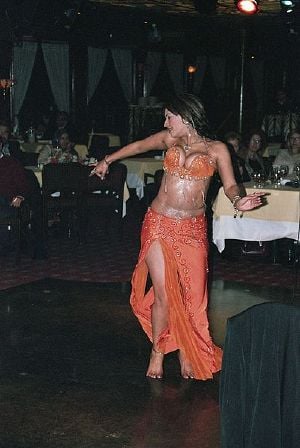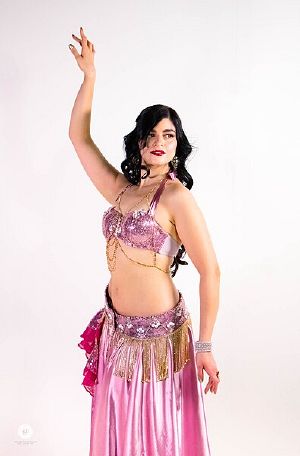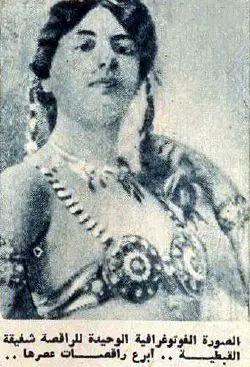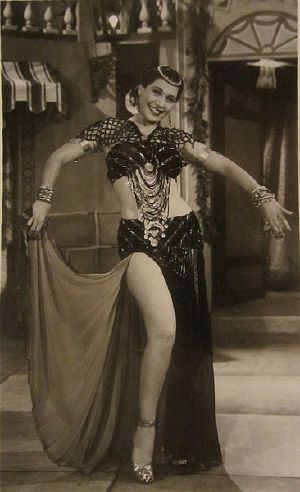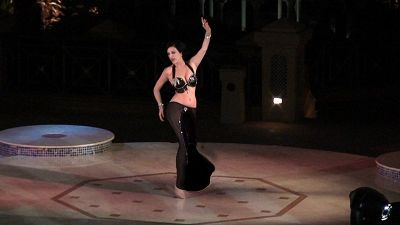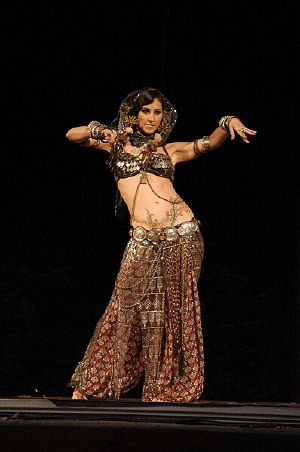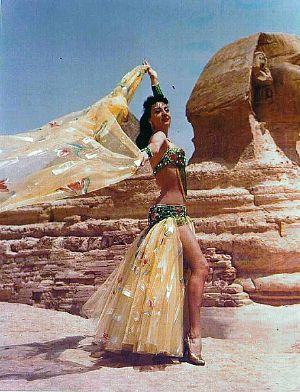Belly dance
Belly dance (Arabic: رقص شرقي) is a Middle Eastern dance which features movements of the hips and torso. The Egyptian styles and costumes are the most recognized worldwide as several dancers rose to fame during the golden years of the Egyptian film industry. However, belly dance has evolved to take many different forms depending on the country and region, both in costume and dance style.
Today, belly dancing in its various styles and forms is popular worldwide, and practiced in many schools around the globe. Its popularity is not limited to the entertainment value of the dance, but also because the style of movement has a number of health benefits. As a low-impact, weight-bearing exercise, belly dance is suitable for all ages and levels of fitness.
Names and terminology
"Belly dance" is a translation of the French term danse du ventre. The name first appeared in 1864 in a review of the Orientalist painting La danse de l'almée (The Dance of the Almeh).[1] However, it is not translated from any Middle Eastern term: "belly dance" is known as "Oriental" or "Eastern" dance in Arabic and Turkish (raqs sharqi and Oryantal dans, respectively).[2]
The first known use of the term "belly dance" in English is found in Charles James Wills, In the land of the lion and sun: or, Modern Persia (1883).[3]
Movements found in belly dance
Belly dance is primarily a torso-driven dance, with an emphasis on articulations of the hips.[4] Unlike many Western dance forms, the focus of the dance is on isolations of the torso muscles, rather than on movements of the limbs through space. Although some of these isolations appear similar to those used in jazz ballet, they are sometimes driven differently and have a different feeling or emphasis.
In common with most folk dances, there is no universal naming scheme for belly dance movements. Many dancers and dance schools have developed their own naming schemes, but none of these is universally recognized. The following attempt at categorization reflects the most common naming conventions:[5]
- Percussive: Staccato movements, most commonly of the hips, used to punctuate the music or accent a beat. Lifts or drops of the hips, chest or rib cage, shoulder accents, hip rocks, hits, and twists.
- Fluid: Flowing, sinuous movements in which the body is in continuous motion, used to interpret melodic lines and lyrical sections in the music, or modulated to express complex instrumental improvisations. These movements require a great deal of abdominal muscle control. Typical movements include horizontal and vertical figures of 8 or infinity loops with the hips, horizontal or tilting hip circles, and undulations of the hips and abdomen. These basic shapes may be varied, combined, and embellished to create an infinite variety of complex, textured movements.
- Shimmies, shivers, and vibrations: Small, fast, continuous movements of the hips or ribcage, which create an impression of texture and depth of movement. Shimmies are commonly layered over other movements, and are often used to interpret rolls on the tablah or riq or fast strumming of the oud or qanun. There are many types of shimmy, varying in size and method of generation. Some common shimmies include relaxed, up and down hip shimmies, straight-legged knee-driven shimmies, fast, tiny hip vibrations, twisting hip shimmies, bouncing 'earthquake' shimmies, and relaxed shoulder or rib cage shimmies.
In addition to these torso movements, dancers in many styles will use level changes, traveling steps, turns, and spins. The arms are used to frame and accentuate movements of the hips, for dramatic gestures, and to create beautiful lines and shapes with the body. Other movements may be used as occasional accents, such as low kicks and arabesques, back bends, and head tosses.
Costume
The costume most commonly associated with belly dance is the bedlah (Arabic: بدلة; literally "suit") style, which typically includes a fitted top or bra, a fitted hip belt, and a full-length skirt or harem pants. The bra and belt may be richly decorated with beads, sequins, crystals, coins, beaded fringe, and embroidery. The belt may be a separate piece, or sewn into a skirt.
The bedlah has changed over the years, as has the dance itself.[6] For example, earlier costumes were made up of a full skirt, light chemise and tight cropped vest with heavy embellishments and jewelry.
As well as the two-piece bedlah costume, full-length dresses are sometimes worn, especially when dancing more earthy baladi styles. Dresses range from closely fitting, highly decorated gowns, which often feature heavy embellishments and mesh-covered cutouts, to simpler designs which are often based on traditional clothing.
Origins and history
Belly dancing is believed to have had a long history in the Middle East.[7] Several Greek and Roman sources including Juvenal and Martial describe dancers from Asia Minor and Spain using undulating movements, playing castanets, and sinking to the floor with "quivering thighs," descriptions that are certainly suggestive of the movements that are today associated with belly dance.[8] Later, particularly in the eighteenth and nineteenth centuries, European travelers in the Middle East such as Edward Lane and Flaubert wrote extensively of the dancers they saw there, including the Awalim and Ghawazi of Egypt.[9]
In his book, Andrew Hammond agrees that belly dance was recognized during early times in Egyptian culture:
The Greek historian Herodotus related the remarkable ability of Egyptians to create for themselves spontaneous fun, singing, clapping, and dancing in boats on the Nile during numerous religious festivals. It's from somewhere in this great, ancient tradition of gaiety that the belly dance emerged.[10]
The courtly pleasures of the Umayyad, Abbasid and Fatimid caliphs included belly dancing, soirée, and singing. Belly dancers and singers were sent from all parts of the vast empire to entertain.[11]
Middle East
Throughout the Middle East and the Arab diaspora, belly dancing is closely associated with Arabic music that is modern classical (known as "al-jadid").[12]
The Egyptian styles and costumes are the most recognized worldwide.
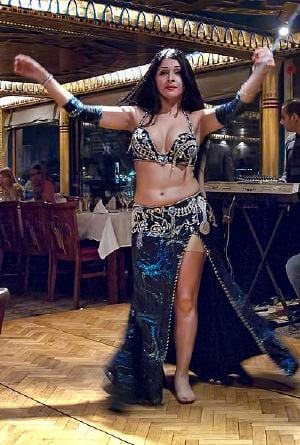
Egypt
Belly dancing is part of Egyptian culture, with tremendous influence on Arabic culture as a whole. In Egypt belly dance has two distinct social contexts: as a folk or social dance.[13]
Raqs sharqi (Arabic: رقص شرقي; literally "Eastern Dance" or "Dance of the Orient") is the classical Egyptian style of belly dance that developed during the first half of the twentieth century. It is a broad category of professional forms of the dance, including forms of belly dance popularly known today, such as Raqs Baladi, Sa'idi, Ghawazee, and Awalim. Belly dancers in Egypt have restrictions placed on their costume and movements. Most notably, no floor work is permitted and the dancer's midriff must be covered.
The informal, social form of the dance is known as Raqs Baladi ("Dance of the Country" or "Folk Dance") in Egyptian Arabic. As a social dance, belly dance is performed at celebrations and social gatherings by ordinary people (male and female, young and old), in their ordinary clothes.[5] In more conservative or traditional societies, these events may be segregated, with men and women dancing separately.[14]
Raqs sharqi was developed by Taheyya Kariokka, Samia Gamal, Naima Akef, Zeinat Olwi, and other dancers who rose to fame during the golden years of the Egyptian film industry. These dancers had a great influence on the development of the Egyptian style, attracting the eyes of the world to the Egyptian belly dance. These dancers were famous not only for their role in Egyptian films, but also for their performances at the "Opera Casino" opened in 1925 by Lebanese-born actress and dancer Badia Masabni. [15]
The changes introduced by Badia Masabni to the oriental dance were aimed at adapting the intimate and improvised Egyptian folk dance into a crowded show and with the spirit of the variety theater or music hall. In order to achieve this Masabni aimed to fill the space, add visual dynamism and give a sensual air to the show. She pioneered theatrical dance tools such as group choreography, movement-extending props, the deliberate use of space on stage, and many more elements of modern entertainment.[16] This venue was a popular place for influential musicians and choreographers from both the US and Europe, so many of the developments pioneered here can be considered new developments in the dance.
Later dancers who were influenced by these artists are Soheir Zaki, Nagwa Fouad, Fifi Abdou, and Dalilah. All rose to fame between 1960 and 1980. Some of these later dancers were the first to choreograph and perform dances using a full orchestra and stage set-up.
Professional belly dance in Cairo has not been exclusive to native Egyptians, although the country prohibited foreign-born dancers from obtaining licenses for solo work for much of 2004 out of concern that potentially inauthentic performances would dilute its culture. (Other genres of performing arts were not affected.) The ban was lifted in September 2004, but a culture of exclusivity and selectivity remained. The few non-native Egyptians permitted to perform in an authentic way invigorated the dance circuit and helped spread global awareness of the art form.[17] American-born Layla Taj is one example of a non-native Egyptian belly dancer who has performed extensively in Cairo and the Sinai resorts.[18]
Turkey
Belly dance is referred to in Turkey as "Oryantal Dans," or simply "Oryantal" literally meaning "orient." Many professional dancers and musicians in Turkey continue to be of Romani heritage, and the Roma people of Turkey have had a strong influence on the Turkish style. In Turkey the style of belly dance is lively and playful, with a greater outward projection of energy than the more contained Egyptian style.[19]
In Turkey dancers are known for their energetic, athletic (even gymnastic) style, and their adept use of finger cymbals, also known as zils, which are commonly used in Egyptian style and movies. Floorwork is also a part of Turkish belly dance. Another distinguishing element of Turkish style is the use of a 9/8 rhythm, divided into 2+2+2+3. This is often referred to as the Karsilama rhythm which is borrowed from the Karşilama folk dance.[19]
Outside the Middle East
Belly dancing has become popular outside the Arab world, and American, European, and Japanese women who have become professional belly dancers dance all over Europe and the Middle East.[20]
North America
Although there were dancers of this type at the 1876 Centennial in Philadelphia, it was not until the 1893 Chicago World's Fair that belly dancing gained national attention. The term "belly dancing" is often credited to Sol Bloom, the Fair's entertainment director, but he referred to the dance as danse du ventre, the name used by the French in Algeria:
When the public learned that the literal translation was "belly dance," they delightedly concluded that it must be salacious and immoral ... I had a gold mine.[21]
Authentic dancers from several Middle Eastern and North African countries performed at the Fair, including Syria, Turkey, and Algeria—but it was the dancers in the Egyptian Theater of The Street in the Cairo exhibit who gained the most notoriety. The fact that the dancers were uncorseted and gyrated their hips was shocking to Victorian sensibilities. The popularity of these dancers subsequently spawned dozens of imitators, many of whom claimed to be from the original troupe. Belly dance drew men in droves to burlesque theaters. Victorian society continued to be affronted by the dance, and dancers were sometimes arrested and fined.[22]
Ruth St. Denis also used Middle Eastern-inspired dance in D. W. Griffith's silent film Intolerance, her goal being to lift dance to a respectable art form at a time when dancers were considered to be women of loose morals. Hollywood began producing films such as The Sheik, Cleopatra, and Salomé, to capitalize on Western fantasies of the orient.
In 1987, a distinctively American style of group improvisational dance, American Tribal Style Belly Dance, (ATS), was created, representing a major departure from the dance's cultural origins. A unique and wholly modern style, it makes use of steps from existing cultural dance styles, including those from India, the Middle East, and Africa.[23]
Many forms of "Tribal Fusion" belly dance have also developed, appropriating elements from many other dance and music styles including flamenco, ballet, burlesque, hula hoop and even hip hop.[24]
Australia
The first wave of interest in belly dancing in Australia was during the late 1970s to 1980s with the influx of migrants and refugees escaping troubles in the Middle East, including Lebanese Jamal Zraika. These immigrants created a social scene including numerous Lebanese and Turkish restaurants, providing employment for belly dancers. Rozeta Ahalyea is widely regarded as the "mother" of Australian belly dance, training early dance pioneers such as Amera Eid and Terezka Drnzik.[25]
Belly dance has now spread across the country, with belly dance communities in every capital city and many regional centers, brought together annually for the Australian Belly Dance Convention.[26]
Spain
In Spain and the Iberian Peninsula, the idea of exotic dancing existed throughout the Islamic era and sometimes included slavery. When the Arab Umayyads conquered Spain, they sent Basque singers and dancers to Damascus and Egypt for training in the Middle Eastern style. These dancers came to be known as Al-Andalusian dancers. It has been suggested that the fusion of the Al-Andalus style with the dances of the Romani people led to the creation of flamenco. Many moves in modern Flamenco are very similar to belly dance.[27]
United Kingdom
Belly dance has been in evidence in the UK since the early 1960s. During the 1970s and 1980s, there was a thriving Arabic club scene in London, with live Arabic music and belly dancing a regular feature,[28] Several prominent members of the British belly dance community began their dance careers working in these clubs.
Today, there are fewer traditional venues for Arabic dance in the UK; however, there is a large amateur belly dance community. Several international belly dance festivals are now held in Britain such as The International Bellydance Congress, The London Belly Dance Festival, and Majma Dance Festival.[29] In addition, there are a growing number of competitions, which have increased in popularity in recent years.
Health
Belly dance is a low-impact, weight-bearing exercise and is thus suitable for all ages and levels of fitness.[30] Many of the moves involve isolations, which improves flexibility of the torso. Belly dance moves are beneficial to the spine, as the full-body undulation moves lengthen (decompress) and strengthen the entire column of spinal and abdominal muscles in a gentle way.
Dancing with a veil can help build strength in the upper body, arm, and shoulders. Playing the finger cymbals (sagat/zills) trains fingers to work independently and builds strength. The legs and long muscles of the back are strengthened by hip movements.[31]
In popular culture
In films
Egyptian belly dancer and film actress Samia Gamal is credited with bringing belly dancing from Egypt to Hollywood and from there to the schools of Europe. In 1954, she famously starred as a belly dancer in the American Eastmancolor adventure film, Valley of the Kings, and the French film Ali Baba and the Forty Thieves.[32]
In British cinema, belly dancing features prominently in several James Bond movies, such as the 1963 movie From Russia With Love, the 1974 movie The Man with the Golden Gun, and the 1977 movie The Spy Who Loved Me.[33]
Belly dancing has been shown in many Bollywood films, and is often accompanied with Bollywood songs and dance sequences instead of the traditional Arabic style. While Bollywood choreographies are based on classical Indian dances, it evolved from a combination of classical Indian dance and folk dancing such as Bhangra, and was merged with Latino and Arabic/belly dance style moves.[34]
In pop music
Belly dance today is a dance used by various artists, including Rihanna, Beyoncé, and Fergie. However, the greatest representative of this dance is the Colombian singer Shakira, whose songs "Whenever Wherever" and "Hips Don't Lie" made her dance skills famous worldwide, popularizing belly dancing in a large part of Latin America and later taking it to the United States. Over time Shakira began mixing this dance with Latin dances, like Salsa[35]
Notes
- ↑ Ainsley Hawthorn, Middle Eastern Dance and What We Call It Dance Research 37(1) (May 2019):1-17. Retrieved April 19, 2024.
- ↑ Teri Williams, Why do we call Middle Eastern dance "belly dance"? Edinburgh University Press Blog, May 23, 2019. Retrieved April 19, 2024.
- ↑ Belly Dance, Noun Oxford English Dictionary. Retrieved April 19, 2024.
- ↑ C. Varga Dinicu (Morocco), You Asked Aunt Rocky: Answers & Advice About Raqs Sharqi & Raqs Shaabi (Hypatia-Rose Press, 2013, ISBN 978-0983069041).
- ↑ 5.0 5.1 Josephine Wise, The JWAAD Book of Belly Dance (JWAAD, 2012, ISBN 978-0957310506).
- ↑ Leyla Amir, Is the Bedlah from Hollywood? The Origin of Our Costume Gilded Serpent, March 28, 2013. Retrieved April 20, 2024.
- ↑ Andrea Deagon, In Search of the Origins of Dance Andrea Deagon's Raqs Sharqi. Retrieved April 12, 2024.
- ↑ Wendy Buonaventura, Serpent of the Nile: Women and Dance in the Arab World (Interlink Books, 2009, ISBN 978-1566567916).
- ↑ Kathleen W. Fraser, Before They Were Belly Dancers: European Accounts of Female Entertainers in Egypt, 1760-1870 (McFarland & Company, 2014, ISBN 978-0786494330).
- ↑ Andrew Hammond, Popular Culture In The Arab World (The American University in Cairo Press, 2007, ISBN 978-9774160547).
- ↑ Muhammed Al Da'mi, Feminizing the West: Neo-Islam's Concepts of Renewal, War and the State (AuthorHouse, 2014, ISBN 978-1491865224).
- ↑ Andrew R. Martin and Matthew Mihalka (eds.), Music around the World: A Global Encyclopedia (ABC-CLIO, 2020, ISBN 978-1610694988).
- ↑ Overview of Belly Dance: Egyptian Folkloric style belly dancing.
- ↑ Rosina-Fawzia al-Rawi, Grandmother's Secrets: The Ancient Rituals and Healing Power of Belly Dancing (Olive Branch Press, 2012, ISBN 978-1566563260).
- ↑ The "Golden Era" of Belly Dance Artemisya Dancewear, March 27, 2020. Retrieved April 23, 2024.
- ↑ Farah Rafik, Badia Masabani: The Force Behind Modern Belly Dance in Egypt Egyptian Streets, May 21, 2022. Retrieved April 23, 2024
- ↑ Shannon Arvizu, "The Politics of Bellydancing in Cairo" The Arab Studies Journal 12/13(2/1) (2004):165.
- ↑ Bio Layla Taj. Retrieved April 23, 2024.
- ↑ 19.0 19.1 Maura Enright, Turkish Orientale Belly Dance Baba Yaga Music. Retrieved April 18, 2024.
- ↑ L.L. Wynn, Pyramids and Nightclubs: A Travel Ethnography of Arab and Western Imaginations of Egypt, from King Tut and a Colony of Atlantis to Rumors of Sex Orgies, Urban legends about a Marauding Prince, and Blonde Belly Dancers (University of Texas Press, 2007, ISBN 978-0292717022).
- ↑ Sol Bloom, The Autobiography of Sol Bloom (G.P. Putnam's Sons, 1948, ISBN 978-1125599662).
- ↑ No More Midway Dancing; Three of the Egyptian Girls Fined $50 Each The New York Times (December 7, 1893). Retrieved April 21, 2024.
- ↑ Kajira Djoumahna, The Tribal Bible, Exploring The Phenomenon That Is American Tribal Style Bellydance (BlackSheep BellyDance, 2003, ISBN 978-0972848602).
- ↑ Jasmine June, An Intro to Tribal Fusion Belly Dance Gilded Serpent, October 28, 2010. Retrieved April 21, 2024.
- ↑ Natalie O'Brien, A night in the life of a bellydancer: Georgette Bowden shimmers across Sydney The Sydney Morning Herald (October 12, 2014). Retrieved April 21, 2024.
- ↑ Australian Belly Dance Convention. Retrieved April 21, 2024.
- ↑ Stacy R. Webb, Belly Dance & Flamenco Retrieved April 21, 2024.
- ↑ Asmahan, The Golden Era of the Arabic Nightclubs in London Gilded Serpent, January 15, 2012. Retrieved April 21, 2024.
- ↑ The Annual UK Belly Dance Congress World Belly Dance. Retrieved April 21, 2024.
- ↑ Tamalyn Dallal, Belly Dancing For Fitness: The Ultimate Dance Workout That Unleashes Your Creative Spirit (Ulysses Press, 2004, ISBN 978-1569754108).
- ↑ Pina Coluccia, Anette Paffrath, and Jean Pütz, Belly Dancing: The Sensual Art of Energy and Spirit (Rochester, VT: Park Street Press, 2005, ISBN 978-1594770210).
- ↑ Samia Gamal, "The Barefoot Dancer" Artemisya Dancewear, March 27, 2020. Retrieved April 21, 2024.
- ↑ Steven Jay Rubin, Belly Dancers Spy Movie Navigator. Retrieved April 21, 2024.
- ↑ Bollywood Belly Dance Atlanta Belly Dance. Retrieved April 21, 2024.
- ↑ Shanice Davis, Shakira Drops Salsa Version Of "Chantaje" Just In Time For Her Birthday Vibe, February 2, 2017. Retrieved April 20, 2024.
ReferencesISBN links support NWE through referral fees
- Al Da'mi, Muhammed. Feminizing the West: Neo-Islam's Concepts of Renewal, War and the State. AuthorHouse, 2014. ISBN 978-1491865224
- Al-Rawi, Rosina-Fawzia. Grandmother's Secrets: The Ancient Rituals and Healing Power of Belly Dancing. Olive Branch Press, 2012. ISBN 978-1566563260
- Bloom, Sol. The Autobiography of Sol Bloom. G.P. Putnam's Sons, 1948. ISBN 978-1125599662
- Buonaventura, Wendy. Serpent of the Nile: Women and Dance in the Arab World. Interlink Books, 2009. ISBN 978-1566567916
- Coluccia, Pina, Anette Paffrath, and Jean Pütz. Belly Dancing: The Sensual Art of Energy and Spirit. Rochester, VT: Park Street Press, 2005. ISBN 978-1594770210
- Dallal, Tamalyn. Belly Dancing For Fitness: The Ultimate Dance Workout That Unleashes Your Creative Spirit. Ulysses Press, 2004. ISBN 978-1569754108.
- Dinicu, C. Varga (Morocco). You Asked Aunt Rocky: Answers & Advice About Raqs Sharqi & Raqs Shaabi. Hypatia-Rose Press, 2013. ISBN 978-0983069041
- Djoumahna, Kajira. The Tribal Bible, Exploring The Phenomenon That Is American Tribal Style Bellydance. BlackSheep BellyDance, 2003. ISBN 978-0972848602
- Fraser, Kathleen W. Before They Were Belly Dancers: European Accounts of Female Entertainers in Egypt, 1760-1870. McFarland & Company, 2014. ISBN 978-0786494330
- Hammond, Andrew. Popular Culture In The Arab World. The American University in Cairo Press, 2007. ISBN 978-9774160547
- Martin, Andrew R., and Matthew Mihalka (eds.). Music around the World: A Global Encyclopedia. ABC-CLIO, 2020. ISBN 978-1610694988
- Wise, Josephine. The JWAAD Book of Belly Dance. JWAAD, 2012. ISBN 978-0957310506
- Wynn, L.L. Pyramids and Nightclubs: A Travel Ethnography of Arab and Western Imaginations of Egypt, from King Tut and a Colony of Atlantis to Rumors of Sex Orgies, Urban legends about a Marauding Prince, and Blonde Belly Dancers. University of Texas Press, 2007. ISBN 978-0292717022
External links
All links retrieved April 23, 2024.
- What is Belly dance? Dance US
- 10 Myths about Belly Dance World Belly Dance
- 5 Benefits of Belly Dance City Academy
- Health Benefits of Belly Dance World Belly Dance
Credits
New World Encyclopedia writers and editors rewrote and completed the Wikipedia article in accordance with New World Encyclopedia standards. This article abides by terms of the Creative Commons CC-by-sa 3.0 License (CC-by-sa), which may be used and disseminated with proper attribution. Credit is due under the terms of this license that can reference both the New World Encyclopedia contributors and the selfless volunteer contributors of the Wikimedia Foundation. To cite this article click here for a list of acceptable citing formats.The history of earlier contributions by wikipedians is accessible to researchers here:
The history of this article since it was imported to New World Encyclopedia:
Note: Some restrictions may apply to use of individual images which are separately licensed.
